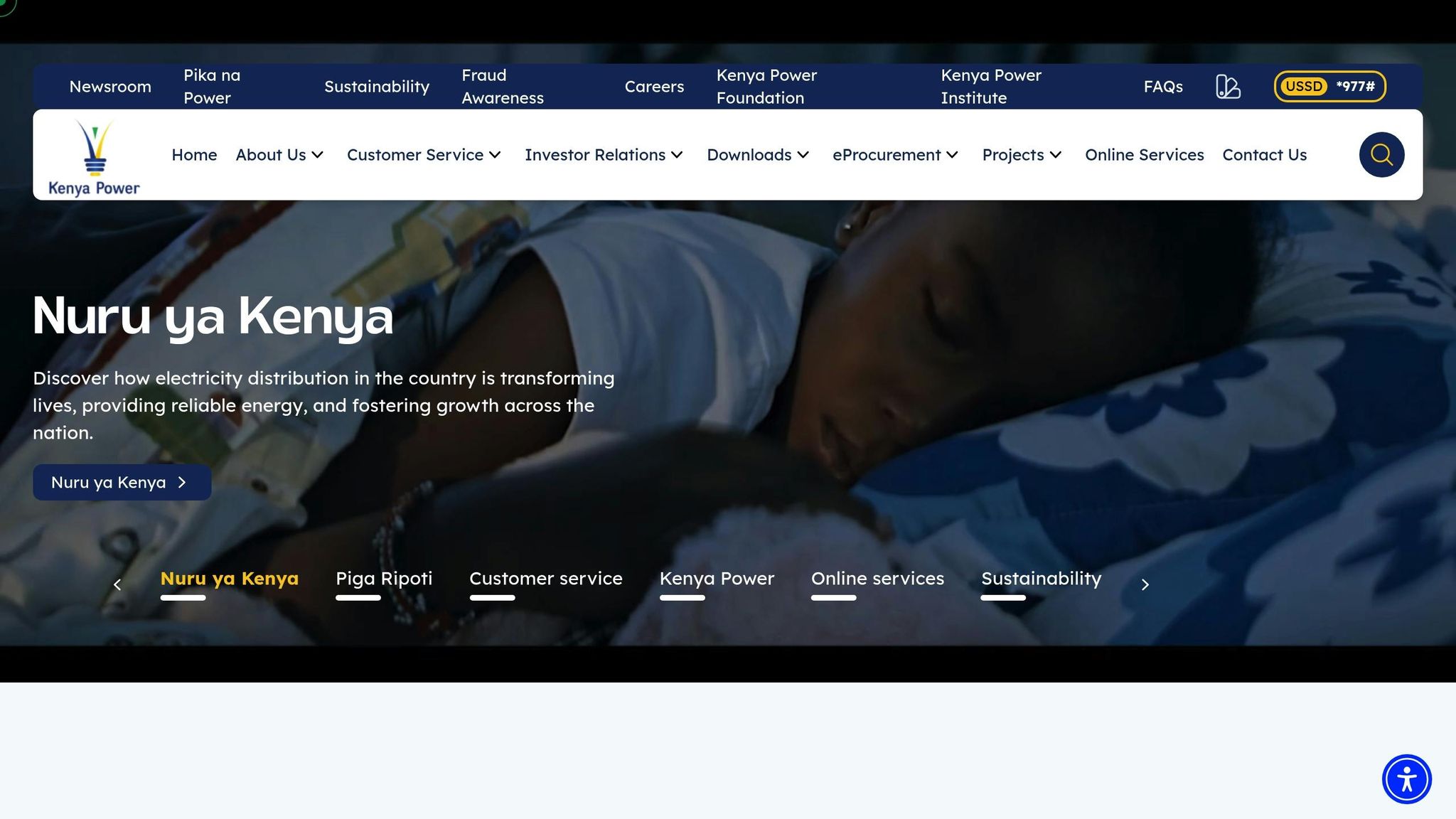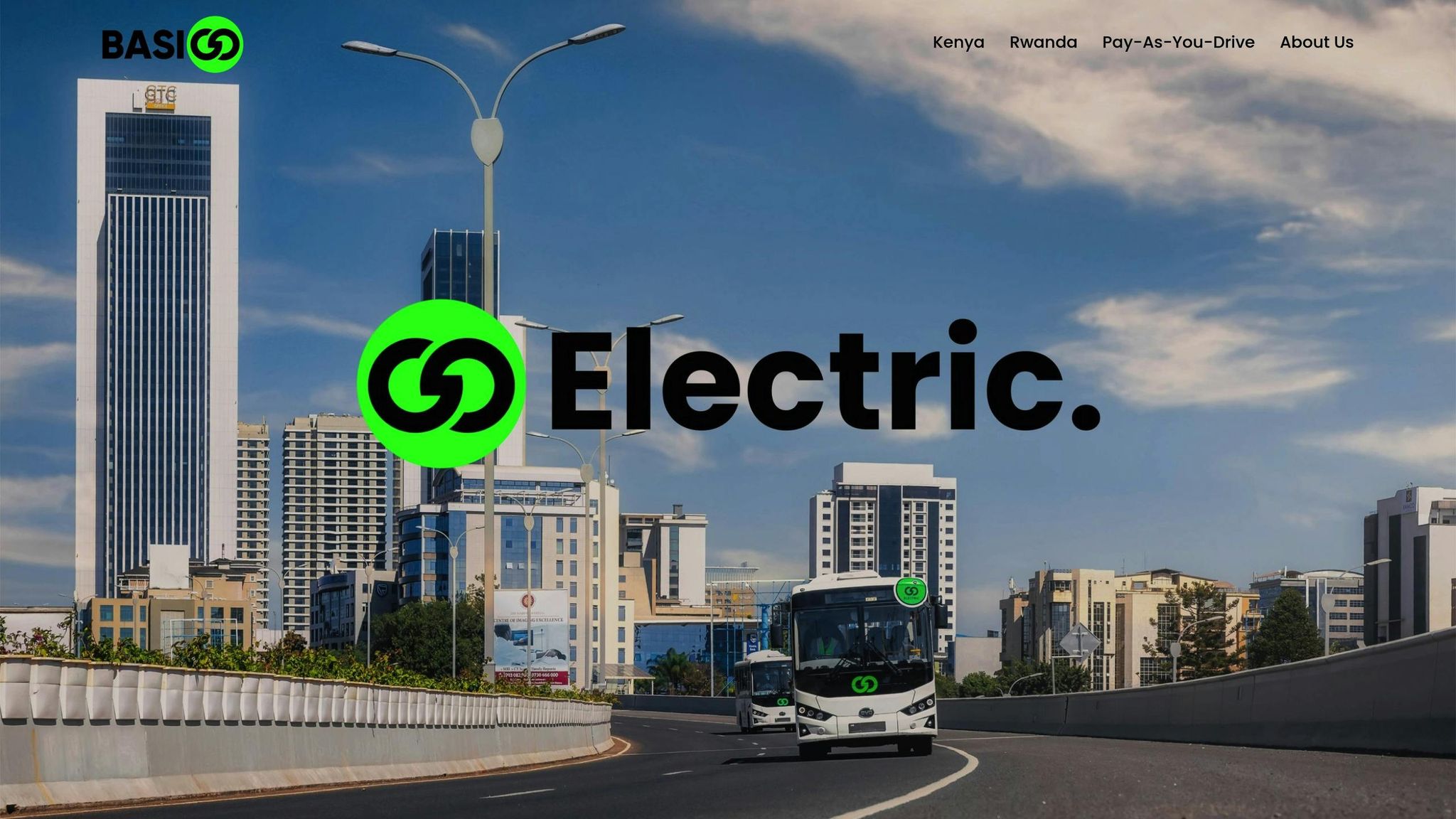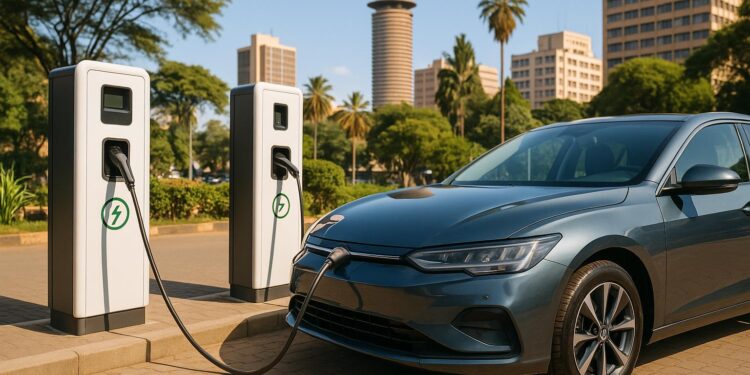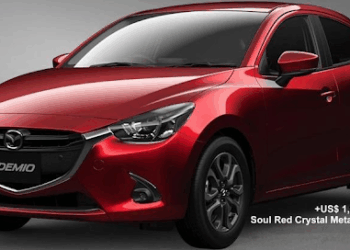Electric vehicles (EVs) are becoming more common in Nairobi, with over 9,000 registered by mid-2025. While Kenya’s renewable energy resources and government incentives make EV ownership affordable, charging infrastructure remains a challenge with only about 20 public stations available. Key players like Kenya Power, TotalEnergies, and BasiGo are expanding charging networks across high-traffic areas, business districts, and transportation hubs. Charging costs are lower than fuel, with rates ranging from $0.06 to $0.12 per kWh, and mobile money like M-Pesa is widely accepted for payments.
Quick Overview
- Current EVs in Kenya: 9,047 (as of May 2025)
- Public Charging Stations: ~20
- Charging Costs: $0.03 per km (vs. $0.11 for gasoline)
- Key Locations: Airports, business districts, retail areas
- Major Providers: Kenya Power, TotalEnergies, BasiGo
- Payment Options: Mobile money, RFID cards, contactless payments
Nairobi’s EV charging network is growing, but finding stations and understanding charging options is key for EV owners. Apps like EVChaja and ChargePoint can help locate stations, while providers continue expanding infrastructure to meet rising demand.
MojaEV Explores: The Public EV Charging Stations in Nairobi !
EV Charging Infrastructure in Nairobi
Nairobi’s electric vehicle (EV) charging infrastructure is expanding rapidly to keep up with the surging demand for EVs. Registrations jumped from 475 in 2022 to 2,694 in 2023, highlighting the growing need for dependable charging options. This rising demand has prompted energy companies and government agencies to accelerate the rollout of charging facilities across the city.
Key Players in Nairobi’s EV Charging Network
Three major providers are leading the charge in building Nairobi’s EV infrastructure, each with distinct strategies and contributions.
Kenya Power has ambitious plans to install 45 EV chargers across six counties, including three in Nairobi. The company is investing KSh 10 billion ($73.4 million) in new substations and power lines to support this initiative .
"Kenya Power is committed to enable the country’s transition to electric mobility to catalyse the reduction of carbon emissions. Part of our plan is to create an enabling environment for players within the e-mobility ecosystem through provision of adequate power supply and the requisite infrastructure such as charging stations that will enable motorists to travel with ease", – Dr. (Eng.) Joseph Siror, Kenya Power’s Managing Director & CEO
Meanwhile, TotalEnergies is leveraging partnerships to expand its network. Collaborating with Ampersand, Roam, and Arc Ride, the company grew its charging sites from 3 in 2022 to 13 in 2023. These locations cater to both EV cars and electric motorbikes, offering charging and battery-swapping services.
"We have established strategic partnerships with three leading e-mobility players namely Ampersand, Roam, and Arc Ride. Leveraging our network of service stations, we have opened 13 EV sites in 2023 as compared to three sites in 2022 providing convenient access to battery charging and swapping points for electric motorbike customers", – TotalEnergies
BasiGo, focusing on public transport, has introduced Kenya’s first DC Fast Charge network for electric buses. The company operates three charging stations in Embakasi, Kikuyu, and Buru Buru, with the Buru Buru site capable of charging six buses simultaneously. BasiGo highlights the environmental impact of their stations, powered by Kenya’s 90% renewable energy grid .
"BasiGo is proud to have our Buru Buru charging station be the first connected through the new E-mobility tariff. Every Electric Bus we deploy and charge replaces the consumption of 20,000 liters per year of imported diesel, with the consumption of 50 MWh of clean, renewable electricity produced here in Kenya." – Jit Bhattacharya, BasiGo CEO
Charging Station Locations
The placement of charging stations in Nairobi is carefully planned to maximize accessibility, focusing on areas with high traffic and strategic importance.
Airport and Transportation Hubs are among the top priorities. Kenya Power has designated six chargers for Jomo Kenyatta International Airport (JKIA), ensuring convenience for domestic and international travelers, as well as supporting airport operations and taxi services .
Business Districts and Commercial Areas host several stations to serve professionals commuting in EVs. Kenya Power operates public charging points at Stima Plaza and Ruaraka, both of which are currently free to help gather research data. The Stima Plaza station represents a KSh 6.5 million ($50,000) investment.
Retail Partnerships are playing a role in expanding accessibility. In February 2025, Roam partnered with QuickMart to set up Roam Hub Charging Stations at select QuickMart locations, with plans to scale to additional stores. QuickMart’s network of 60 branches across 16 counties provides a solid foundation, though the initial focus remains on Nairobi.
Residential and Mixed-Use Areas also benefit from strategically placed stations. BasiGo’s locations in Embakasi, Kikuyu, and Buru Buru are positioned along bus routes, ensuring convenience for daily operations.
This diverse network caters to the needs of commuters, commercial drivers, and long-distance travelers. For instance, Roam’s four operational stations in Nairobi have already facilitated 4,000 charging and rental transactions, sold over 10 MWh of energy, and powered more than 250,000 electric kilometers. Additionally, these stations have created over 20 jobs, showcasing the economic benefits of the growing EV infrastructure.
"This partnership not only enhances the accessibility of electric vehicle charging but also aligns with our commitment to integrating sustainable solutions into everyday life" – Habib Lukaya, Energy & Charging Product Manager at Roam
These efforts not only improve accessibility but also pave the way for smoother EV adoption, setting the stage for the next steps in Nairobi’s e-mobility journey.
Public Charging Station Locations
Finding the right charging station in Nairobi depends on your needs – whether it’s a quick top-up or a longer charging session. Nairobi’s charging network is spread across major transport hubs and commercial areas, each with its own benefits. Below, we’ll look at some key providers shaping the city’s public EV charging landscape.
Kenya Power Charging Stations

Kenya Power has launched pilot charging stations at Stima Plaza and Ruaraka, offering free charging services as part of their research efforts. The Stima Plaza facility, which cost KSh 6.5 million ($50,000) to set up, includes both fast and standard chargers. It features a 50kW DC charger that can fully charge a vehicle in about an hour and a 22kW AC charger that takes around two hours.
To use these stations, you’ll need to get an RFID card available at the security desks at either location.
"The two electric vehicle (EV) chargers, one at Stima Plaza and the other at Ruaraka, will be open for free use by members of the public who own EVs, primarily to assist the Company in its research and development." – Kenya Power
Kenya Power is also planning to expand its charging network with additional stations at Jomo Kenyatta International Airport (JKIA). Meanwhile, TotalEnergies offers another network of charging stations in key commercial zones.
TotalEnergies Charging Stations

TotalEnergies has leveraged its existing fuel station sites to set up EV charging points in high-traffic areas. By 2023, the company had expanded to 13 charging sites, up from just three in 2022.
Notable locations include stations on Lusaka Road, Waiyaki Way, and Ngong Road. In May 2023, Roam introduced electric motorcycle charging stations, or Roam Hubs, at these sites. These hubs go beyond charging, offering services like battery rentals, spare parts, and maintenance tailored for boda-boda operators.
"The roll-out of this dedicated charging network for electric motorcycle riders is an important step in Roam’s vision towards decarbonising Kenya’s boda-boda sector." – Roam
These stations cater to both EV cars and motorbikes, with options for battery-swapping services. TotalEnergies has partnered with companies like Ampersand, Roam, and Arc Ride to grow its network quickly while ensuring quality service. Most locations operate during regular business hours, though exact timings may vary.
BasiGo Charging Facilities

BasiGo operates three advanced charging stations in Embakasi, Kikuyu, and Buru Buru, primarily designed for electric buses but also open to private EV users. Among these, the Buru Buru station stands out as the most advanced, capable of charging up to six buses at once.
In May 2023, BasiGo launched Nairobi’s first public e-bus fast charging station in Buru Buru. This facility is part of Kenya’s push toward electrified public transport and is equipped to handle various vehicle types.
"Charging stations such as this reflect the future of an electrified public transit system and address reliable charging infrastructure, which is a key challenge in implementing electric public transport." – BasiGo
These stations run on Kenya’s renewable energy grid, which is 90% clean. Each electric bus charged here replaces around 20,000 liters of imported diesel annually with 50 MWh of locally produced renewable electricity.
The Embakasi and Kikuyu stations are strategically located along major bus routes, making them accessible for both public transport and private EV owners. While focused on commercial vehicles, these facilities highlight the potential for scaling up Nairobi’s EV infrastructure to meet growing demand.
How to Charge Your EV in Nairobi
Charging your EV in Nairobi involves finding a station, connecting your vehicle, and paying for the service, all while selecting the right type of charger for your needs.
Finding Charging Stations
To locate charging stations in Nairobi, apps like PlugShare, ChargePoint, and EVChaja are your go-to tools. These apps let you search for stations based on your vehicle type, charging speed, and budget. For instance, ChargePoint provides details about pricing and charger availability, while Electrify America highlights fast-charging options. Specifically for Kenya, EVChaja offers a dedicated app to help users find charging points across the country.
Though apps like Google Maps and Waze can show some charging locations, they typically list fewer options compared to EV-specific apps. Dedicated apps also provide real-time updates and user reviews, making it easier to check station availability before heading out. These tools are essential for navigating Nairobi’s growing EV infrastructure.
Charging Steps at the Station
After finding a charging station, park your EV so the charging cable can easily reach your port. Connect the cable to your vehicle’s charging port, which follows standardized designs.
Payment methods vary by station. While newer chargers often support contactless payments, older ones may require you to set up an account. At Kenya Power stations, such as those at Stima Plaza and Ruaraka, you’ll need to get an RFID card from the security desk to use the free charging service offered as part of their research program.
AC vs. DC Charging Types
Nairobi’s public charging network includes two main types of chargers: AC chargers and DC chargers.
- AC chargers (often called destination chargers) are slower and work well when you can leave your car plugged in for a while, like during a shopping trip or a meal.
- DC chargers, on the other hand, are much faster and ideal for quick stops when you’re short on time. For example, BasiGo’s CCS-2 DC fast chargers are compatible with certain passenger cars and deliver a rapid charge.
Knowing the difference between AC and DC chargers helps you plan your stops efficiently, ensuring you pick the option that fits both your schedule and your EV’s requirements.
sbb-itb-e5ed0ed
Costs, Payment Methods, and Helpful Tools
Charging an electric vehicle (EV) in Nairobi is not only affordable but also makes budgeting straightforward.
Charging Costs and Rates
On average, charging an EV in Nairobi costs about KSh 4 ($0.03) per kilometer, compared to KSh 14 ($0.11) per kilometer for gasoline-powered vehicles. This difference demonstrates the potential savings of switching to electric.
Special e-mobility tariffs are available, ranging from KSh 8 ($0.06) during off-peak hours to KSh 16 ($0.12) during peak hours. These rates are lower than the standard domestic electricity rate of KSh 20.97 ($0.16) per kWh for usage above 100 kWh.
Public charging stations in Nairobi typically charge between KSh 20 and KSh 50 ($0.15 to $0.38) per kWh. Pricing can vary depending on the station’s location, the amenities provided, and the speed of the charger. Some stations also offer subscription plans, which can reduce the cost per kWh for frequent users. Charging during off-peak hours can lead to savings of up to 30% on electricity bills.
Now, let’s look at the payment options available to EV owners.
Payment Options
Nairobi’s EV charging stations support various payment methods, with mobile money being the most popular. M-Pesa is widely accepted, making it a convenient choice for most Kenyan EV drivers.
Some stations use RFID cards, which require users to set up an account with the charging operator. Membership accounts often offer lower rates, while non-members may face higher fees.
Newer charging stations accept contactless credit and debit cards, while older ones may rely on dedicated apps or RFID systems. Pay-as-you-go options are also available, allowing occasional users to pay directly with a credit or debit card.
In 2022, Kenya Power initiated plans to develop EV charging infrastructure that would allow payments through the M-Pesa app.
Many stations also integrate payments into dedicated charging apps, which securely store payment details and automatically process transactions when you plug in your vehicle.
Let’s explore how these apps and tools can enhance the EV charging experience.
Apps and Tools for EV Owners
Several apps are designed to make finding and using charging stations easier. For example:
- EVChaja, Kenya’s first EV charging network, offers a mobile app for both iOS and Android devices. It provides locally-focused information on charging stations across the country.
- ChargePoint, a highly-rated app with a 4.5/5 score on Google Play from over 52,500 reviews, connects users to a vast charging network. It features real-time station availability, filters for specific charger types, and integrated payment options. Recent updates have improved its design and stability.
- EV Connect, rated 4.5/5 on the App Store with 6,000 reviews, helps users locate and pay for EV charging. It’s praised for its user-friendly interface and responsive customer service, though station availability can vary. In April 2025, the app’s version 4.1.2 introduced bug fixes and performance improvements.
- Electromaps is another valuable tool, offering a global directory of charging stations. It supports trip planning for longer journeys, making it a great option for those traveling outside Nairobi.
These apps often include features like real-time notifications when charging is complete, expense tracking, and filters to find chargers compatible with specific EV models, such as AC or DC fast chargers. With these tools, managing your EV charging becomes much simpler and more efficient.
Future of EV Charging in Nairobi
Nairobi is on the brink of a major transformation in its electric vehicle (EV) charging infrastructure, fueled by ambitious government plans and growing private sector involvement.
Planned Charging Station Expansions
Kenya Power has announced plans to roll out 45 EV charging stations across six counties within the next year. Among these, six chargers will be installed at Jomo Kenyatta International Airport (JKIA), providing travelers and airport staff with convenient charging options. The remaining stations will be distributed across Nairobi, Nyeri, Kisumu, Eldoret, Nakuru, Mombasa, and Taita Taveta counties.
This expansion is happening alongside a surge in EV registrations. The number of registered EVs jumped from 2,694 in 2023 to 5,294 in 2024, and further reached 9,047 by May 2025 [3, 36].
Government Policies and Industry Support
Policies are playing a crucial role in driving the EV transition. The Kenyan government aims to establish 10,000 EV charging stations nationwide by 2030. Additionally, the National Building Code 2024 mandates that all commercial buildings allocate 5% of their parking spaces for EV charging, ensuring that new developments are ready for this growing demand.
Financial incentives are also boosting growth. For instance, in April 2024, Kenya Power committed KSh 258 million (approximately $1.9 million) over three years to expand the charging network. Preferential electricity tariffs for charging stations further reduce operational costs.
"We are working with the private sector players to identify the energy and infrastructure needs within the e-mobility space to inform the deployment of the right strategies that will accelerate EV adoption in Kenya." – Joseph Siror, Kenya Power Managing Director
The National E-Mobility Strategy includes additional measures like tax deductions for the EV sector and a target to electrify 5% of Kenya’s vehicle stock by 2025.
"Our focus is to work closely with the Government of Kenya to advocate for policies that will continue to incentivize EV adoption such as tax exemptions and subsidies for electric vehicles and charging infrastructure." – Joy Brenda Masinde, Kenya Power’s Chairman of the Board of Directors
Expected Technology Improvements
Beyond infrastructure and policies, advancements in technology are set to enhance the EV charging experience in Nairobi. By 2030, hundreds of charging stations are expected across Nairobi, Mombasa, and Kisumu, providing a well-connected network that alleviates drivers’ range anxiety.
The market will likely see more affordable EV models from brands like BYD, Nissan, MG, and Tesla, making EV ownership more accessible. Residential and office buildings are also expected to integrate charging points, allowing users to conveniently charge their vehicles at home or work. Emerging service models, such as mobile charging and on-demand EV maintenance, aim to fill gaps where fixed stations may not be available.
One of the critical challenges is standardizing charging technology. Consistency in battery sizes, communication protocols, safety standards, and charging parameters is essential for creating a seamless user experience.
"Standardization is the backbone of trust in any system. In EV swapping, it means a rider can pull into any station, regardless of provider, and get back on the road in minutes. That’s the future we’re building." – Thatcher M. Mweu, Operations Lead, Mazi Mobility
These advancements will make EV ownership in Nairobi more practical and user-friendly, aligning with the government’s vision of a sustainable and reliable charging network for all drivers.
Conclusion
Nairobi’s electric vehicle (EV) charging network is growing at an impressive pace, making EV ownership increasingly practical and convenient. With key players like Kenya Power, TotalEnergies, and BasiGo rolling out charging stations throughout the city, EV drivers now have multiple reliable options to keep their vehicles charged and ready. This progress paves the way for even greater advancements in the near future.
Looking ahead, Kenya is planning to install 700 charging stations in urban centers and another 300 along highways. This ambitious plan highlights the country’s commitment to creating a well-connected charging infrastructure. Beyond convenience, this expansion brings significant benefits: reducing dependence on fossil fuels, cutting air pollution, and opening up new opportunities in industries tied to EVs. Additionally, EVs provide a more stable and predictable fueling option compared to the fluctuating costs of petrol and diesel.
Kenya is positioning itself as a leader in sustainable transportation within the region. As E-Safiri emphasizes:
"Kenya has the potential to become a regional leader in e-vehicle adoption and eco-friendly transportation systems by implementing proactive government measures, clear regulations, and collaborative partnerships."
For both current and future EV owners in Nairobi, the message is unmistakable: the infrastructure is growing rapidly, making electric mobility not just a vision but a reality today.
FAQs
How can I find the closest EV charging station in Nairobi using an app?
Finding the nearest EV charging station in Nairobi is straightforward with the help of mobile apps tailored for this purpose. Apps like PlugShare offer detailed maps, user reviews, and real-time updates on station availability, making it easy to locate a charging spot. Another handy option is Google Maps – just type "EV charging stations", and you’ll see nearby locations.
These tools simplify the process of planning your charging stops, ensuring a smoother experience for EV owners in Nairobi.
What’s the difference between AC and DC EV charging stations in Nairobi, and how do I choose the best option?
In Nairobi, AC charging stations are usually Level 2 chargers. These are slower but easier on your wallet and your EV’s battery, making them ideal for daily use. You’ll often find them in convenient spots like shopping malls or parking lots.
On the other hand, DC fast chargers are all about speed. They can often recharge your EV in roughly an hour, which makes them a great choice for longer journeys or when you’re pressed for time. The trade-off? They’re generally more expensive than AC chargers.
Choosing between the two depends on your driving habits and how you plan to charge. For everyday, budget-friendly charging, stick with AC chargers. But if you’re on a road trip or need a quick boost, DC fast chargers are the way to go.
What is the Kenyan government doing to expand EV charging stations and promote electric vehicles?
The Kenyan government is stepping up its efforts to boost electric mobility by expanding EV charging infrastructure. Through Kenya Power, plans are underway to set up 45 new EV charging stations across key counties like Nairobi, Mombasa, Kisumu, Eldoret, Nyeri, and Nakuru within the next year. This move aims to make charging stations more accessible, encouraging more people to embrace electric vehicles.
On a larger scale, the government is also integrating EV-friendly features into major infrastructure projects. For instance, the $3.5 billion Nairobi–Mombasa Expressway will include EV charging points, aligning with Kenya’s broader push for sustainable transportation and greener energy solutions.
Related posts
- Guide to Electric Vehicle Charging Stations in Kenya
- Ultimate Guide to Eco-Driving in Kenya
- Car prices in Nairobi 2025
- Electric Cars in Kenya: Which Ones Are Available Right Now ⚡️




